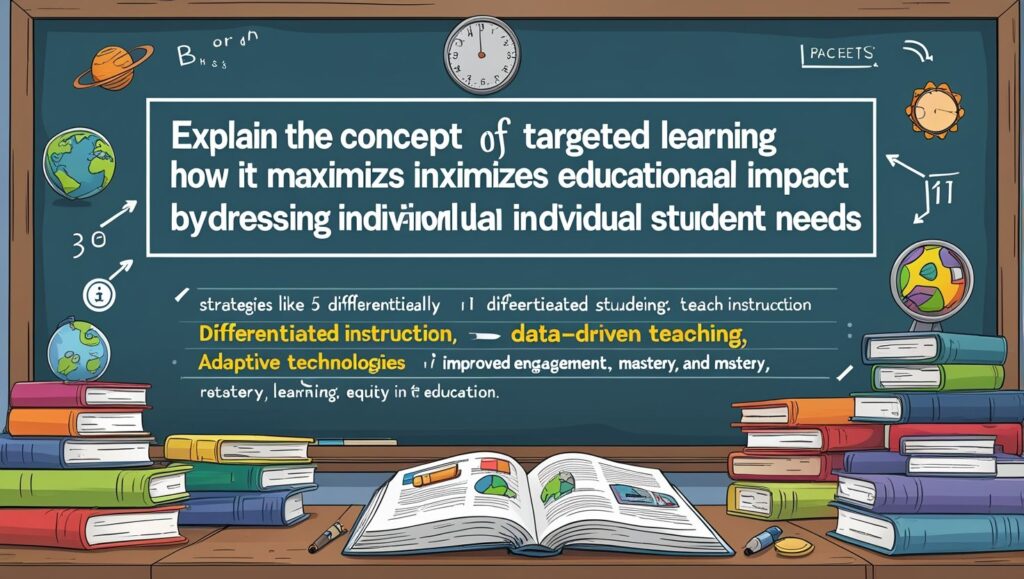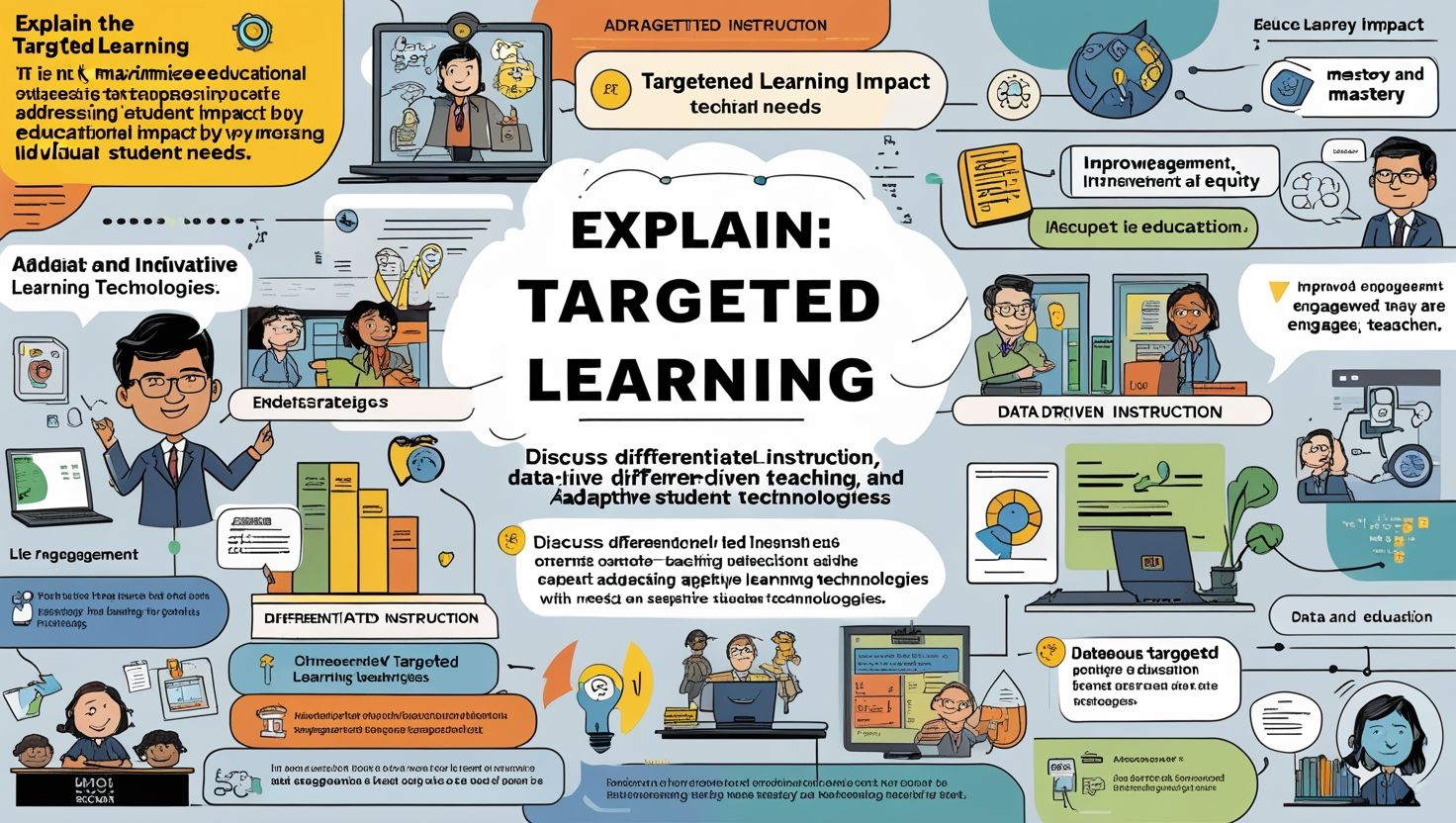Introduction
Targeted Learning Maximizing Educational Impact in the dynamic landscape of education, where personalized learning and tailored instruction are increasingly emphasized, targeted learning stands out as a powerful approach to maximizing educational impact. This method goes beyond traditional, one-size-fits-all teaching strategies by pinpointing individual needs and adapting educational content and techniques accordingly. By focusing on the unique strengths, weaknesses, and learning styles of each student, targeted learning not only enhances academic achievement but also fosters a deeper engagement with the learning process.
Understanding Targeted Learning
Targeted learning can be seen as a continuum of differentiated instruction, which aims to cater to diverse learner needs within a classroom. However, it takes customization a step further by utilizing data-driven insights to refine and adapt teaching strategies. At its core, targeted learning relies on:
- Data-Driven Insights: Utilizing assessments, analytics, and student performance data to identify specific areas where students may need additional support or challenges.
- Personalized Instruction: Tailoring learning experiences, content, and pacing to align with individual student needs, abilities, and interests.
- Adaptive Technologies: Incorporating educational technologies and tools that can adjust content delivery and assessment based on real-time feedback.
Implementing Targeted Learning Strategies
1. Assessment and Data Analysis
Targeted Learning Maximizing Educational Impact central to targeted learning is the systematic collection and analysis of data related to student performance. Teachers use formative assessments, standardized tests, and observational data to gather insights into each student’s strengths and weaknesses. For example, digital platforms can provide detailed analytics on how students interact with learning materials, identifying specific concepts that require reinforcement.
2. Individualized Learning Plans
Based on data analysis, educators develop individualized learning plans (ILPs) for students. These plans outline specific learning goals, instructional strategies, and assessment methods tailored to address each student’s academic needs. ILPs may include differentiated assignments, personalized projects, or adaptive learning software to support student progress.

3. Adaptive Learning Technologies
Technology plays a pivotal role in targeted learning by offering adaptive learning platforms and tools. These technologies use algorithms to adjust the difficulty and pace of content delivery based on individual student performance. For instance, an adaptive math program may provide additional practice problems on fractions for a student struggling with the concept while offering more advanced topics to a student who has mastered the basics.
4. Differentiated Instruction Strategies
In the classroom, differentiated instruction strategies accommodate diverse learning preferences and abilities. Teachers may employ tiered assignments, flexible grouping, or alternative assessments to meet the needs of various learners. For example, a science teacher might offer different reading levels of a text or provide hands-on activities alongside traditional lectures to cater to different learning styles.
Benefits of Targeted Learning
1. Improved Academic Outcomes
By addressing individual learning needs and adapting instruction accordingly, targeted learning has been shown to improve academic performance. Students receive the support and challenges they need to master content and achieve learning objectives effectively.
2. Enhanced Student Engagement
Personalized learning experiences increase student engagement and motivation. When students feel that their unique strengths and interests are recognized, they are more likely to participate actively in the learning process and take ownership of their education.
3. Efficient Use of Resources
Targeted learning optimizes resource allocation by focusing interventions and support where they are most needed. Teachers can allocate time and instructional materials more effectively, maximizing the impact of educational investments.
4. Preparation for Lifelong Learning
By promoting self-directed learning and critical thinking skills, targeted learning prepares students for future academic and professional challenges. Students develop resilience and adaptability as they learn to navigate diverse learning environments and adapt to new information.

Challenges and Considerations
Implementing targeted learning strategies is not without challenges:
- Data Privacy and Security: Safeguarding student data privacy while utilizing digital tools and analytics.
- Teacher Training: Ensuring educators are proficient in using data and technology to inform instructional decisions.
- Equity and Access: Addressing disparities in access to technology and resources among students from different socioeconomic backgrounds.
Conclusion
Targeted learning represents a paradigm shift in education, emphasizing personalized and data-driven approaches to enhance student outcomes. By leveraging insights from assessments and adaptive technologies, educators can create tailored learning experiences that meet the unique needs of each learner. As schools continue to integrate targeted learning strategies into their curriculum, the focus remains on fostering a supportive and inclusive learning environment where every student can thrive.
In summary, targeted learning is not just about delivering information; it’s about empowering students to achieve their full potential through customized educational experiences. As educational technology evolves and our understanding of individual learning needs deepens, targeted learning promises to remain at the forefront of educational innovation, shaping the future of teaching and learning.

I was suggested this blog by means of my cousin. I am not sure whether this submit is written through him as nobody else recognize such specified about my difficulty. You are incredible! Thank you!
Nikmati Permainan Slot Gacor di sigmaslot dengan RTP Tinggi dan Jackpot Menggoda
Wake up your way with this premium CD player alarm clock radio. Whether you prefer to rise with the AM/FM radio, your favorite CD, or a standard buzzer, this versatile alarm clock with CD player has you covered. Its intuitive design includes dual alarms, a large digital display, snooze/sleep timers, and USB charging for your phone. Enjoy high-quality stereo sound from a compact unit that fits easily on any bedside table or shelf. The best clock radios with CD player combine retro functionality with modern convenience—and this one leads the pack.
I believe this site holds very fantastic written articles posts.
Hello. excellent job. I did not anticipate this. This is a great story. Thanks!
You are my inhalation, I own few web logs and very sporadically run out from to brand : (.
Having read this I thought it was very informative. I appreciate you taking the time and effort to put this article together. I once again find myself spending way to much time both reading and commenting. But so what, it was still worth it!
Good day! I know this is kinda off topic however , I’d figured I’d ask. Would you be interested in trading links or maybe guest writing a blog post or vice-versa? My blog covers a lot of the same subjects as yours and I feel we could greatly benefit from each other. If you are interested feel free to send me an e-mail. I look forward to hearing from you! Fantastic blog by the way!
I together with my buddies were viewing the best tips on the website and all of the sudden got a horrible suspicion I never thanked the web site owner for those secrets. Those guys are already absolutely very interested to read them and have now in truth been enjoying them. Appreciate your getting indeed considerate and also for selecting this kind of remarkable information millions of individuals are really needing to discover. Our honest apologies for not expressing appreciation to you sooner.
hello there and thanks on your information – I’ve definitely picked up something new from right here. I did alternatively experience some technical issues the usage of this site, as I skilled to reload the website a lot of occasions previous to I could get it to load correctly. I had been wondering if your hosting is OK? No longer that I’m complaining, however sluggish loading circumstances instances will sometimes impact your placement in google and can injury your high quality rating if advertising and ***********|advertising|advertising|advertising and *********** with Adwords. Anyway I am adding this RSS to my email and can look out for much extra of your respective exciting content. Make sure you update this once more very soon..
Thank you a bunch for sharing this with all folks you really recognise what you are talking approximately! Bookmarked. Please additionally consult with my site =). We can have a hyperlink exchange agreement between us!
It’s really a nice and useful piece of info. I’m satisfied that you just shared this useful information with us. Please keep us up to date like this. Thanks for sharing.
Thanks for this post, I am a big fan of this web site would like to go along updated.
Good info and straight to the point. I am not sure if this is in fact the best place to ask but do you guys have any thoughts on where to get some professional writers? Thanks 🙂
Enjoyed reading this, very good stuff, thankyou. “To be positive To be mistaken at the top of one’s voice.” by Ambrose Bierce.
Absolutely indited content material, Really enjoyed examining.
Perfectly indited articles, Really enjoyed reading.
I got good info from your blog
great post.Never knew this, regards for letting me know.
Hi would you mind letting me know which webhost you’re utilizing? I’ve loaded your blog in 3 different web browsers and I must say this blog loads a lot faster then most. Can you recommend a good internet hosting provider at a fair price? Thank you, I appreciate it!